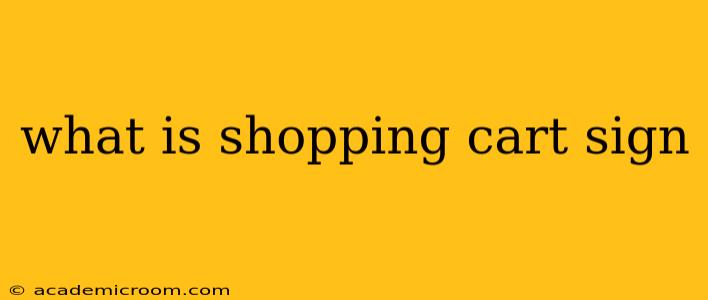The shopping cart sign, universally recognized as a small, stylized image of a shopping cart or basket, is the icon that signifies the addition of items to a customer's online order. It's a crucial element of e-commerce design, acting as a visual cue guiding users through the purchasing process. But its significance extends beyond simple aesthetics; it represents a critical point in the customer journey.
What does the shopping cart icon represent?
The shopping cart sign represents the virtual holding place for items a customer intends to purchase. Clicking this icon, usually located near product listings, adds the selected item to the "shopping cart" or "basket" – a temporary storage area within the website's system. This area allows customers to review their selections, adjust quantities, and proceed to checkout when ready. It's the visual manifestation of the customer's intent to buy.
Why is the shopping cart icon important for e-commerce?
The shopping cart icon plays a vital role in several aspects of e-commerce:
-
User Experience (UX): It provides a clear and intuitive way for users to add items to their order. The simplicity and universal understanding of the icon contribute to a smoother, more user-friendly shopping experience. A well-placed, easily visible shopping cart icon significantly reduces user friction.
-
Conversion Rates: A clear and easily accessible shopping cart icon contributes directly to higher conversion rates. When users can effortlessly add items to their cart, they are more likely to complete the purchase.
-
Branding and Recognition: Although variations exist, the basic shopping cart icon is so widely understood that it's become a powerful visual shorthand for online shopping, contributing to brand recognition and immediate comprehension of the website's function.
-
Progress Indicator: The shopping cart icon, often displaying a number indicating the quantity of items, serves as a progress indicator for the user. It allows them to track their shopping progress and easily return to their cart at any time.
How does the shopping cart sign differ from other e-commerce symbols?
While the shopping cart sign is synonymous with adding items to an online order, other symbols serve distinct purposes:
- Heart Icon (Wishlist): This indicates adding an item to a wishlist for later purchase.
- Compare Icon: Allows customers to compare products before making a decision.
- Search Icon: Facilitates searching for specific products.
- Checkout Icon: Indicates the final stage of the purchasing process.
These icons, while all part of the e-commerce experience, have different functions and serve distinct purposes within the customer journey.
What are the different variations of shopping cart icons?
While the basic concept remains consistent, subtle variations exist in the design of shopping cart icons. Some are more realistic depictions of a shopping cart, while others are simplified or stylized versions. The specific design often aligns with the overall branding and aesthetics of the website. However, the core visual representation—a cart or basket—always remains easily recognizable.
Is the shopping cart icon always located in the same place on a website?
No, the placement of the shopping cart icon varies across websites. While typically found in the upper right corner of the page, its position depends on the website's design and user interface. Some sites may place it in the header, while others might place it in a floating bar or within a sidebar. Regardless of placement, accessibility and visibility remain critical for optimal user experience.
In conclusion, the humble shopping cart sign is far more significant than its simple appearance suggests. It’s a critical element in the success of online stores, acting as a bridge between browsing and purchasing, contributing significantly to user experience and overall conversion rates. Its widespread understanding and consistent use demonstrate its enduring importance in the world of e-commerce.
